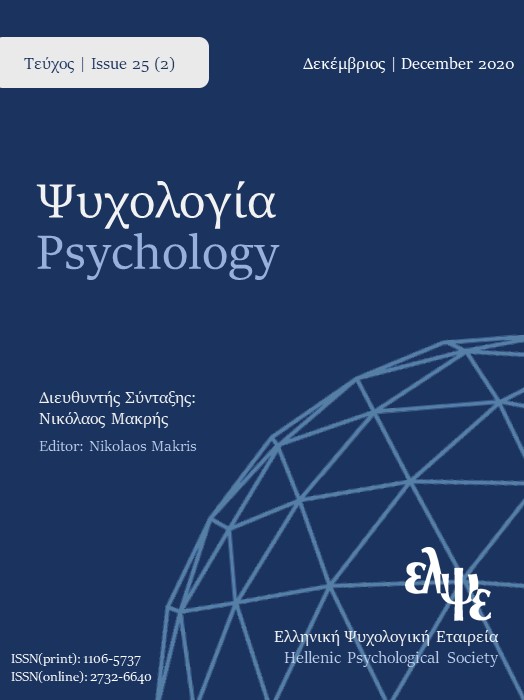Οι μάσκες δεν φιλιούνται. Η επίδραση της COVID-19 στην σεξουαλική συμπεριφορά των Ελλήνων ανδρών και γυναικών

Περίληψη
Η COVID-19 επηρέασε τη συναισθηματική κατάσταση καθώς και τη σεξουαλική συμπεριφορά των ανθρώπων σε όλον τον κόσμο εξαιτίας των συνθηκών κοινωνικής απομόνωσης, των περιορισμών της καραντίνας αλλά και των οικονομικών επιπτώσεων. Η παρούσα ποσοτική έρευνα εξετάζει την επίδραση της COVID-19 στην σεξουαλική συμπεριφορά του ελληνικού πληθυσμού, λαμβάνοντας υπόψη τη ψυχική δυσφορία, τον τύπο συγκατοίκησης και την οικογενειακή κατάσταση. Μία σειρά από ερωτηματολόγια χορηγήθηκε σε 221 Έλληνες, γυναίκες και άντρες, σε σχέση ή χωρίς, με σκοπό να μελετηθεί ο τρόπος που η COVID-19 έχει συμβάλλει στην ψυχική δυσφορία τους και έχει επηρεάσει τη σεξουαλική συμπεριφορά τους. Η μέθοδος που χρησιμοποιήθηκε είναι μία παραγοντική (με τρεις ανεξάρτητες μεταβλητές) πολυμεταβλητή ανάλυσης συνδιακύμανσης. Σύμφωνα με τα αποτελέσματα η πανδημία της COVID-19 επηρέασε αρνητικά τα επίπεδα ψυχικής δυσφορίας και τη σεξουαλική συμπεριφορά γυναικών και αντρών. Στην πλειοψηφία των συμμετεχόντων βρέθηκαν ήπια επίπεδα δυσφορίας τα οποία συνδέονται με την COVID-19 και επηρεάζουν τη συνολική σεξουαλική συμπεριφορά. Ταυτόχρονα, ο τύπος συγκατοίκησης συνδέεται άμεσα με τη σεξουαλική λειτουργία, ενώ η οικογενειακή κατάσταση επηρεάζει και τις γυναίκες και τους άντρες με διαφορετικό όμως τρόπο. Στο μέλλον θα μπορούσε να μελετηθεί η σεξουαλική συμπεριφορά του ελληνικού πληθυσμού χρησιμοποιώντας διαφορετικές μετρήσεις όσον αφορά την πιθανή συναισθηματική επιρροή της COVID-19, όπως επίσης να ερευνήθει τη σεξουαλική συμπεριφορά ατόμων με ειδικές ανάγκες και ψυχικές διαταραχές.
Λεπτομέρειες άρθρου
- Πώς να δημιουργήσετε Αναφορές
-
Δαουλτζής Κ. Χ., & Ελευθεριάδου Α. (2022). Οι μάσκες δεν φιλιούνται. Η επίδραση της COVID-19 στην σεξουαλική συμπεριφορά των Ελλήνων ανδρών και γυναικών. Ψυχολογία: το περιοδικό της Ελληνικής Ψυχολογικής Εταιρείας, 27(3), 47–62. https://doi.org/10.12681/psy_hps.28776
- Ενότητα
- ΕΜΠΕΙΡΙΚΕΣ ΕΡΓΑΣΙΕΣ

Αυτή η εργασία είναι αδειοδοτημένη υπό το Creative Commons Attribution-ShareAlike 4.0 International License.
Το περιοδικό ΨΥΧΟΛΟΓΙΑ έχει υιοθετήσει μία πολιτική Platinum open-access. Τα έξοδα υποβολής, επεξεργασίας ή δημοσίευσης των εργασιών καλύπτονται από την Ελληνική Ψυχολογική Εταιρεία. Τα πνευματικά δικαιώματα των δημοσιευμένων εργασιών προστατεύονται από την άδεια 'Creative Commons Attribution-ShareAlike 4.0 International'. Οι Συγγραφείς διατηρούν τα Πνευματικά Δικαιώματα και χορηγούν στο περιοδικό το δικαίωμα της πρώτης δημοσίευσης. Η άδεια αυτή επιτρέπει σε τρίτους, να χρησιμοποιούν την εργασία σε οποιαδήποτε μορφή, με την προϋπόθεση της διατήρησης των διατυπώσεων που προβλέπονται στην άδεια σχετικά με την αναφορά στον αρχικό δημιουργό και την αρχική δημοσίευση στο περιοδικό ΨΥΧΟΛΟΓΙΑ. Επιπλέον, κάθε διανομή της εργασίας οφείλει να γίνεται με τους ίδιους όρους διανομής, δηλαδή με την ίδια άδεια Creative Commons.




